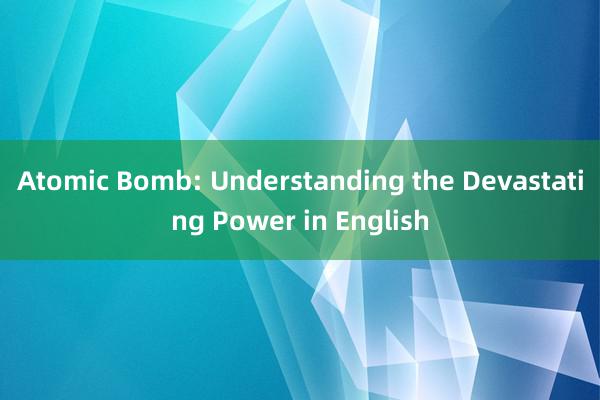
# Atomic Bomb: Understanding the Devastating Power
The atomic bomb, a pivotal weapon of the 20th century, represents a significant milestone in the history of warfare and science. Its destructive power was unprecedented and continues to cast a long shadow over the global political landscape. This article aims to provide an overview of the atomic bomb, its development, and the devastating effects it had on humanity.
## Origin and Development
The concept of nuclear fission, the splitting of heavy atoms into lighter ones releasing a large amount of energy, was first proposed by Lise Meitner and Otto Hahn in 1938. However, it was not until the late 1940s that this theoretical knowledge was translated into a practical weapon. The Manhattan Project, a secret research and development undertaking involving many scientists, engineers, and manufacturers, was established by the United States government to develop nuclear weapons during World War II. Led by scientists like J. Robert Oppenheimer, the project successfully created two atomic bombs.
## Theoretical Understanding
The power of an atomic bomb lies in its ability to harness the energy released from the rapid splitting of atomic nuclei. In a nuclear chain reaction, one nucleus splits, 松溪人才网_松溪招聘网_松溪人才市场 releasing neutrons that cause other nuclei to split, 淮北市相山区子萱美甲店 creating a self-sustaining process. The energy released from these reactions is enormous,丹阳林锐工具有限公司 equivalent to several thousand tons of TNT or more, depending on the size of the bomb.
## The Impact on Hiroshima and Nagasaki
On August 6, 1945, the United States dropped the atomic bomb "Little Boy" on the Japanese city of Hiroshima. The bomb, containing uranium-235,海口美兰嘉繁文化传媒工作室 exploded with a yield of approximately 15 kilotons of TNT, causing immediate destruction and long-term health effects. Over 70,000 people were killed instantly, and the number rose to over 140,000 by the end of the year due to radiation sickness and injuries.
Two days later, on August 8, 1945, a second atomic bomb, "Fat Man," was dropped on the city of Nagasaki. This bomb used plutonium-239 and had a yield of about 20 kilotons of TNT. The destruction was similar, but the number of deaths was slightly lower, estimated at around 80,000, including both immediate fatalities and those who succumbed to injuries and radiation poisoning later.
## Aftermath and Legacy
江门市德惠家庭用品进出口有限公司The use of atomic bombs against Japan marked the end of World War II and led to Japan's unconditional surrender. However, the moral and ethical implications of using such weapons have been widely debated. The bombings raised questions about the value of human life, the role of technology in warfare, and the potential for global nuclear annihilation.
The legacy of the atomic bomb includes ongoing efforts towards disarmament and non-proliferation, as well as the development of international laws and treaties to prevent their use in the future. The bombings also underscored the importance of international cooperation in scientific research and the need for global governance to address existential threats.
## Conclusion
The atomic bomb stands as a testament to the immense power of science and its potential consequences. It serves as a stark reminder of the devastating impact of warfare and the urgent need for global peace and understanding. As humanity continues to advance technologically海口美兰嘉繁文化传媒工作室, the lessons learned from the atomic bomb remain crucial in guiding our actions towards a safer, more peaceful world.
